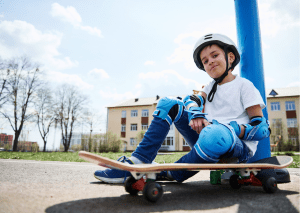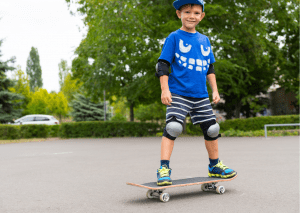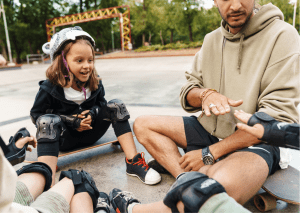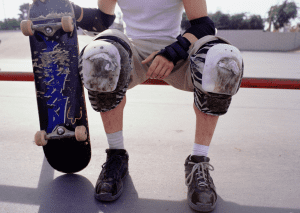Safe Skateboarding
Skateboarding safety is essential for skateboarders. Read these skateboarding safety tips to prevent injuries while riding!

It’s always a good idea to learn new things. This article will guide you through the essential skateboarding lessons and safety tips that every skateboarder should know under adult supervision. From choosing the right gear and understanding skateboard mechanics to practicing safe techniques and maintaining your board, it’s essential. It’s not only about protecting yourself from skateboarding injuries but also about respecting those around you by adhering to skating etiquette.
Whether you’re an experienced skateboarder or just starting, stick with us as we take you through these crucial topics for an enjoyable and safe ride! Everyone knows that skateboarding safety should be the top priority for skateboarders to enjoy their tricks and time spent at skateboard parks or on the streets to the fullest.
Key Takeaways
When riding a skateboard, you’re expected to observe certain safety standards. Safety, confidence, caution, and fun are all essential attributes and values when it comes to skating under adult supervision on irregular surfaces, as the risk of severe injuries and safety is not optional. Wearing protective equipment, you can practice some of our highly recommended skateboarding safety tips. By following these tips, you can hit the pavement with confidence and caution, and have many fun-filled, healthy skate rides ahead!
Safety Lessons In Skateboarding
You might think it’s all about the skating tricks and speed on the top surface, but without prioritizing slip-resistant skateboarding safety and health in skating, you’re missing a crucial piece of the puzzle—it’s not just about preventing severe skateboarding injuries, but also ensuring a long-lasting passion for this thrilling sport.
Skating injury prevention and risk awareness are important. By serving others with these valuable teachings, we can create a safer community of skaters. When skateboarders fall, as it’s bound to happen occasionally, the right protective skateboard gear can minimize damage to the body. Now let’s get to know how choosing the right skateboard gear and wearing a protective suit, like a skating helmet, wrist guards, knee pads, elbow pads, and other gear, especially in wet weather, can contribute to our mission, as recommended by the American Academy of Pediatrics.
It’s essential to find the best skate equipment that offers both comfort and protection. With the right skateboarding safety gear, skateboarders can protect themselves from serious skateboarding injuries, while still enjoying the thrill of the sport. You would be able to skate with confidence and have fun while prioritizing our skateboarding safety tips.
Here, we have broken down the safety standards when you ride a skateboard.

Choosing The Right Gear
Selecting the appropriate gear isn’t just about looking cool, it’s a crucial step towards ensuring you’re protected while enjoying this exhilarating sport. Everyone understands the importance of staying safe, and that’s why people are encouraged to customize their gear specifically to their needs.
Not only is it important to find and choose the right skateboard and protective gear to get the most out of your skating experience, but it’s also important to make sure that the equipment is affordable so that you don’t have to break the bank for safety. The importance of understanding skateboard basics for a safer and more enjoyable ride. It’s essential to be aware of skating principles such as balance, speed, and coordination and how they all play a part in the safety and enjoyment of this sport, as recommended by the American Academy of Pediatrics.
Understanding The Basics
If you’re serious about skateboarding, mastering some of the crucial skateboarding safety tips is a must. Doing so can significantly increase your overall skills and make each ride more satisfying. Equally vital are safety tips that can protect different parts of your body during a ride, such as understanding your center of gravity.
To successfully master skateboarding, understanding the different skateboard designs and their unique features, learning basic skateboarding tricks to boost your confidence, and getting familiar with how to maintain balance while executing moves are all key. It’s also imperative to choose safe places to practice and to invest in good protective gear like a multi-sport helmet. These skills pave the way for mastering safe skateboarding techniques, which will enhance your overall skateboarding performance on the board.
By investing time in understanding skateboard basics, you not only enjoy the thrill of every trick but also stay safe and derive satisfaction from each skateboarding ride, as recommended by the American Academy of Pediatrics.
Improving your skills properly on the skateboard isn’t just about nailing those awesome skateboarding tricks; it’s also crucial to practice falling techniques and methods that will keep you from taking a nasty spill. This article guides injury prevention and risk assessment methods. Skateboarding on common and various surfaces as an activity is a thrilling sport, but it’s important to remember that caution is the key to mastering it safely to avoid serious head injury.

A skateboard consists of a board, wheels, bearings, trucks, and hardware. Safety equipment, such as helmets, wear a helmet that fits well, skating helmets, wrist guards, and knee and elbow pads, should be worn at all times. Wearing new slip-resistant shoes is also a good idea for better control, especially when indulging in styles like freestyle and roll-like speed.
Additionally, it’s important to familiarize yourself with proper skateboarding etiquette and safety rules, and always be aware of your surroundings. This includes following any local skateboarding laws and regulations, being respectful of other skateboarders, and being mindful of pedestrians. The importance of skateboarding etiquette for an all-rounded experience. When skateboarding, it’s essential to be aware of the rights of way for other skateboarders, pedestrians, and cars.
Additionally, it’s important to be courteous to other skateboarders, even if they’re more experienced than you. You should also never litter, graffiti, or otherwise damage property. Finally, it’s important to be aware of your skill level and not attempt tricks that could cause injury or serious harm.
Understanding And Respecting Etiquette
Understanding and respecting skateboarding etiquette isn’t just about being a good sport, it’s also about making the skate park or street a more enjoyable place for everyone. Skateboarders, as members of the extreme sports community, should take responsibility for their actions.
Boarding respect and etiquette implementation are key to ensuring skateboard safety and harmony among riders. They help us serve our fellow skaters better, fostering a supportive environment. Now, it’s important to keep in mind that skateboarding etiquette includes practices such as courteousness, politeness, and respect for others. Following the skateboard safety guidelines will make you an ethical skateboarder.
Safe Skateboarding
- Prevents Conflicts: Courteous behaviors, such as waiting your turn or giving space to others, prevent potential misunderstandings or clashes in a crowded skatepark.
- Promotes Inclusivity: By being courteous, seasoned skaters can create an inclusive environment that’s welcoming for beginners, ensuring the continued growth of the skateboarding community.
- Politeness: Knowing skateboard polite interactions not only enhances the skateboarding experience for participants but also creates a favorable impression on onlookers or anyone unfamiliar with the sport.
- Fosters Positive Interactions: A simple acknowledgment, thank-you, or compliment can bolster the camaraderie among skaters, leading to mutual appreciation and friendship.
- Valuing Diversity: Skateboarding is a global sport with diverse participants. Respect for others ensures that people of all backgrounds, skill levels, and experiences feel valued and included.
- Conservation of Skate Spots: Respect also extends to the environment. By treating skate spots with care and discouraging behaviors like littering, skaters can ensure that these places remain accessible and in good condition.
- Prevention of Skateboarding Injuries: Respect for skateboard safety norms, such as wearing protective gear or being mindful of one’s surroundings, drastically reduces the chances of skateboarding injuries.
- Ensuring Enjoyment for All: A safe skate park or spot means that everyone can enjoy their time without the constant fear of accidents. This enhances the overall experience and ensures that the spot remains popular and utilized. Moreover, proper maintenance of your skateboard is essential for safe skateboard riding practices
Ultimately, skateboarding etiquette is essential for creating an enjoyable environment for everyone, so make sure to stay mindful and respectful of other riders and their property.
Tips For Maintaining Your Board
Maintaining your skateboard is essential for your safety and for achieving your customization goals. Regular checks and tweaks can ensure deck durability, giving you a smooth ride every time. Just like learning tricks, skateboard maintenance should be an integral part of your skating journey.
Skateboard Safely
Let’s explore the different parts of a skateboard and the different ways you can keep your four-wheeler in tip-top shape! Keeping your skateboard in good condition involves checking on the deck, wheels, trucks, and bearings for any signs of wear and tear from contact with the ground. The deck should be inspected for any signs of wear and tear, such as dents, scratches, and chips.
The wheels should be checked for any damage or uneven wear, and the trucks should be tightened if loose, ensuring a smooth ride for many skaters. Lastly, the bearings should be lubricated to ensure a smooth ride. It’s important to remember that proper skateboard maintenance not only ensures a safe and smooth ride but also allows you to customize your board in the way you want.

Conclusion And Final Thoughts
We’ve learned a great deal about staying safe while skateboarding, a sport belonging to the action sports class. It discusses skateboards, protective gear like skateboard helmets and elbow pads, skateboard safety lessons, techniques, etiquette, and skateboard maintenance.
Frequently Asked Questions
Can I Skateboard Safely?
To learn to skateboard safely and prevent skateboarding injuries, it’s essential to start with the skateboarding basics and progress gradually. Wearing proper safety skateboarding equipment, such as a skateboarding helmet, knee pads, and elbow pads, can help prevent serious injury.
How Do I Stay Safe While Skateboarding?
To protect yourself while skateboarding and make skateboarding safer, always wear safety skateboarding protective gear, including a skateboarding helmet, wrist guards, knee pads, and elbow pads. Learning how to fall properly on the fleshy parts of your body, by rolling or sliding instead of catching yourself with your hands, can also reduce the risk of severe skateboarding injuries. Wear a helmet always.
What Skateboarding Skills Should I Learn?
The first skills to learn in skateboarding are usually standing on the board, with your front foot near the middle of the board and your back foot on the tail, pushing off, and learning to balance while moving. Turning and stopping come next, followed by basic tricks like an ollie or kick turn. Remember, never ride a skateboard near a car or a motor vehicle. Not even on irregular surfaces, so you won’t land on the fleshy side of your body.
How Do You Prepare For Skateboarding?
To prepare for skateboarding as a recreational activity, ensure you have the correct skateboard safety gear including a multi-sport helmet and a good-quality skateboard. Do some stretching exercises to warm up your body before you start, and find a smooth, flat area or skate park to practice in.
What Should I Avoid When Skateboarding?
When skateboarding, especially in skate parks, do not neglect wearing protective gear, attempt tricks beyond your skill level without proper progression, or skateboard in unsafe environments with traffic. Respect for others and public property is also important in the skateboarding community.
How Do I Get Over My Fear Of Skateboarding In Public?
Overcoming the fear of skating in public, as a person on a skateboard, often comes with time and practice, learning how to roll effectively. Start by practicing in less crowded areas or times, and remember that everyone learns at their own pace and even experienced skaters have to start somewhere.
How Do I Protect My Wrists When Skateboarding?
One of the most crucial skateboarding safety tips is to protect your wrists and other parts of your body while skating, as a person on a skateboard, it’s recommended to wear skating wrist guards that add support and help absorb impact. Additionally, learning to fall correctly and not falling on the fleshy parts of your body can help prevent most skating injuries.
How Do You Teach A Beginner Skater?
When teaching children and parents as a beginner skater, start with the basics: how to stand on the skateboard, how to push and stop, and how to balance, making it enjoyable for kids. Always emphasize the importance of wearing protective gear and proper falling techniques for kids and adults, as recommended by the American Academy of Pediatrics.
How Do You Balance On A Skateboard?
For beginners to balance on a skateboard, it’s crucial to start with the right stance – feet shoulder-width apart, one foot near the front of the board, and knees slightly bent to avoid falling on the fleshy parts of your body. Practice shifting your weight to turn the board while stationary before trying it while moving in case of an emergency. Start on a soft surface to lessen the impact of falls.
How Long Does It Take To Learn How To Skateboard?
The time it takes to learn skateboarding varies greatly from person to person. Some may be comfortable with the skateboarding basics after a few days, while others might take several weeks. Regular practice, wearing closed-toe shoes, and persistence can speed up the process, but if severe head injuries occur, it’s important to seek professional help.
Just like riding a motor vehicle, head injury is inevitable when you skate without wearing proper safety gear. Hence, it’s a good idea to learn some skateboard safety tips to avoid head injury.
Follow these tips properly, especially when skateboarding in rough areas. Feel free to share this guide when you find anybody who needs this in handy.
DISCLAIMER (IMPORTANT): This information (including all text, images, audio, or other formats on FamilyHype.com) is not intended to be a substitute for informed professional advice, diagnosis, endorsement or treatment. You should not take any action or avoid taking action without consulting a qualified professional. Always seek the advice of your physician or other qualified health provider with any questions about medical conditions. Do not disregard professional medical advice or delay seeking advice or treatment because of something you have read here a FamilyHype.com.